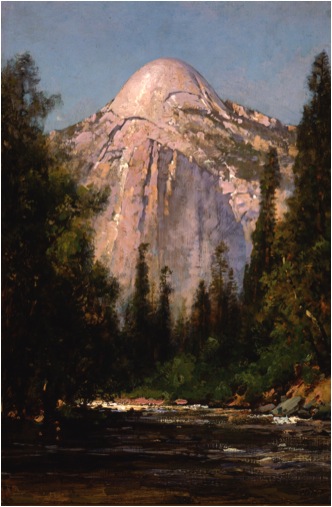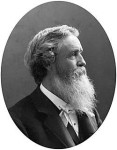
Thomas Hill
English, 1829-1908 (active USA)
North Dome from Bridge, 1880s, ca.
oil on canvas
SBMA, Gift of Mrs. William T. Swain

Photograph of Thomas Hill, Wawona, July 15, 1906 by I.W. Taber
RESEARCH PAPER
Thomas Hill was born in Birmingham, England on September 11, 1829 into a poor family. His father was a tailor and sailed to the U.S. to find full-time employment in 1843. Thomas' interest in painting started at the early age of seven. He pursued his interest in art in professions such as painting carriages, decorating furniture and assisting interior decorators. He joined his father along with his mother, brothers and sisters in Taunton, MA. Hill married in 1851 and in 1853, he enrolled in art classes under Peter Rothermel at the Pennsylvania Academy of Fine Arts. He continued his studies in Paris in 1866 for six months with the German painter, Paul Meyerheim, who strongly urged him to specialize in landscape. Hill was determined to make a living as a fine arts painter. Active in Boston art circles, Hill was member of the "While Mountain School" of landscapists which included Benjamin Champney, Asher B. Durand, George Innes, Albert Bierstadt and Virgil Williams. In 1859 to 1960 he made a living as a furniture painter at the Levi Heywood Company in Gardner Massachusetts. He was highly regarded as a painter, but he wasn't satisfied with his progress. The hardship of the death of his two children from diphtheria and tuberculosis caused Hill to move his surviving family to the warmer climate of California: they settled in San Francisco. Initially, he supported the family as a sign and ornamental painter. In 1862, he painted portraits and landscapes from sketches in his studio. His first trip to Yosemite was in 1862 where he has struck by the sheer beauty and magnificence of it all. Fame came from the prolific works of Yosemite and other California landscapes. During his career, he won thirty on awards for his dramatic paintings of American landscape.
North Dome from Bridge represents the classic grandeur of Hill's expertise, his love of nature and of the Yosemite Valley. It is a classic Bierstadt-Hill representation of the majestic beauty of Yosemite Valley. The work describes the scale of nature. It is organized with strong vertical, horizontal and diagonal lines that take place in nature. The brushstrokes create a realistic textural effect and add depth and drama to the scene. Rough brush strokes on the Dome emphasis the magnitude. The strong colors with a heavy impasto palette effect the imposing size of the Dome.
Words that come to mind in describing the painting: peace, serenity, solitude and a feeling of being encapsulated with the incredible beauty of nature. It takes you to the place, you can visualize being in a magnificent place of natural beauty and reminds one of being there. If you have never visited Yosemite, just by viewing this painting, you can envision being there in all it's splendor. Hill has not replace Bierstadt, but it is his own interpretation of the beauty that Bierstadt painted before him. "Hill's paintings evoked pride in the American landscape leading to the preservation of these regions as State and National Parks." In 1903, Hill gave President Theodore Roosevelt, who was instrumental in preserving so much land for our National Parks, a large painting of "Bridal Veil Fall" which Roosevelt admired. Hill contributed greatly to American landscape painting by his evocative representations of nature.
1. Critique of Thomas Hill of September 23, 1980, of work shown at the Oakland Museum, "The Grand View of Thomas Hill."
BIBLIOGRAPHY
Arkelian, Marjorie. Thomas Hill -The Grand View . Oakland, California. Oakland Museum Art Department, 1980.
Prepared for the SBMA Docent Council By Robert G. Sharp, 2003

Artist Thomas Hill's studio, exterior. In the summer of 1886 Hill established his studio next to the Wawona Hotel in Yosemite, where he sold paintings to tourists. Photograph by George Fiske.
SBMA CURATORIAL LABELS
English-born Thomas Hill began his artistic career in the 1850’s in New England but with his trip to the west in 1861, he became one of the first painters to devote himself to the landscape and natural wonders of California. After a visit to Yosemite in 1862, he began to paint views of the area (which had only been discovered in 1855), both great panoramic vistas of the mountains and small, vivid studies of meadows, trees, waterfalls and other details of its then pristine landscape. Fascination with the western United States and a growing popular taste for landscape art, along with the flourishing economy of California in the 1870’s led to Hill’s financial and critical success. After travel in Europe and the eastern United States, Hill established his studio in Yosemite Valley and continued to make scenery of this area his primary subject, despite changing taste in art toward the end of the 19th century.
His work suffered from neglect for decades, like that of Albert Bierstadt and other artists of their time, only to be re-evaluated in the middle of the 20th century. Due to renewed interest in 19th-century American art and the pioneering collection of the Oakland Museum in the 1950’s, we have come to appreciate the accomplishments of Thomas Hill and the legacy of his vision of Yosemite in all its variety and beauty.
- Robert Henning, Former Director for Curatorial Services, SBMA
